1983 Monaco Grand Prix race report
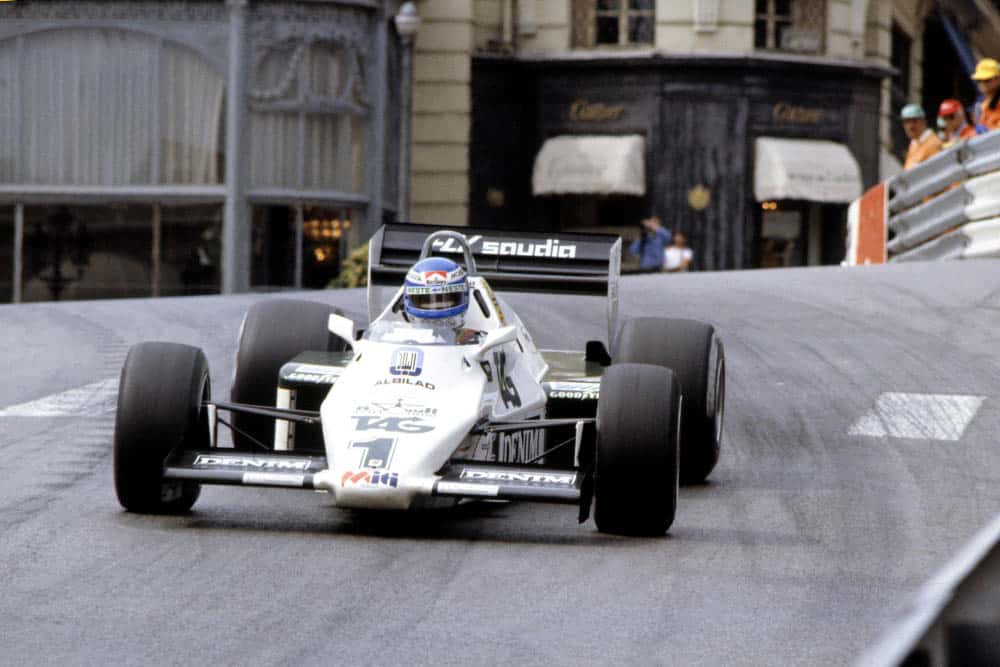
Keke Rosberg came through from 5th to win
Motorsport Images
Gambler’s luck
Monte Carlo, May 15th
The planning of the 1983 Grand Prix season is not working out too well. It started off all right in Brazil, with everyone surprisingly fit and ready to race, then the scene moved to Long Beach where there was an all-pervading atmosphere of it being the last Formula One race in the Californian sea-port town. The European scene began entirely on the wrong foot, by having the French Grand Prix in April instead of its traditional mid-summer date in July; added to which it was held at the featureless Paul Ricard circuit and afterwards there was the feeling that the European season had not really begun. Then came the San Marino GP at Imola and all was alive and well with a superb meeting, a great race, a fantastic atmosphere and you really felt that 1983 was under way. This was followed by the Monaco Grand Prix which is always abundant in atmosphere and at the end of the first day of practice things were looking good with Renault and Ferrari in a toe-to-toe battle. But then the rain came. Monte Carlo in the rain is awful. You might as well be at Cleethorpes.
As usual the Automobile Club of Monaco produced its own rules for the Grand Prix, which are at variance in many ways with the rest of the world. The first difference was the limitation of only 20 cars on the starting grid, and the second was the restriction of petrol in the pits, which effectively banned high-pressure refuelling and pit stops. The limitation on the number of starters was easily solved by a qualifying session at 8 a.m. on Thursday morning for those teams that did not score any points in last year’s Manufacturers Championship, which were Toleman, March and Theodore, so Warwick, Giacomelli, Guerrero, Cecotto and Salazar were out bright and early and the fastest three were to move up into the serious business of practice and qualifying due to start at 10 a.m. Everything that could go wrong did go wrong with the Toleman team and Warwick had to use all three team cars before he got in a decent lap, and the Theodore-Ensign team successfully eliminated itself with very little effort. Cecotto crashed and Guerrero’s car broke a driveshaft, so Salazar with the lone RAM-March and the shambolic Toleman team were the survivors to join the rest for the official practice.
In spite of a number of spectacular accidents in the San Marino GP none of the cars involved had to be scrapped, which says a lot for the constructional methods used in today’s Formula One cars and rebuilding was achieved without too much trouble. After the time-wasting exercise of changing the pedals and seat in the spare Ferrari to suit either Arnoux or Tambay, the Scuderia solved the problem by arriving at Monaco with four cars, two for Arnoux (064 and 062) and two for Tambay (065 and 063). The only other team that indulges in this luxury is Lotus who have two Renault powered cars for De Angelis (93T/1 and 93T/2) and two Cosworth powered cars for Mansell (92/10 and 92/5). After the first appearance of the 1983 Cosworth DFY engine at Paul Ricard, they are now well in production and Team Tyrrell joined the ranks, along with McLaren and Lotus, and though the DFY is better than the DFV in many respects it is still no answer to the power shortage that Ferrari, Renault and BMW make increasingly obvious at each successive meeting.

Elio de Angelis in his Lotus 93Y.
Motorsport Images
At Imola Ferrari had suffered from vapour bubbles getting into the injection system, so all four cars at Monaco were fitted with a control by the driver’s left shoulder which operated a valve in the fuel system on the left side of the engine which was effectively a de-aerator.
Renault arrived with their two team cars carrying a lot of modifications (RE40/03 and RE40/02), while the spare car (RE40/01) was unmodified. Instead of the exhaust pipes and the boost-control outlet pipe exiting upwards just in front of each rear wheel, where much of the heat was blown onto the rear tyres, the exhaust from the turbine on each side split into three small-diameter tail pipes of the same diameter as the boost-control-valve pipe. These four pipes on each side were fed downwards and out under the rear axle assembly and exhausted into a neatly shaped tunnel formed by fibre-glass panels around the gearbox and under the rear of the car. A cold-air duct was fed onto each boost control valve unit, none of this new arrangement being passed to Team Lotus for the moment, though the spare works Renault was fitted with this new kit by Sunday morning. With such major changes to the exhaust system on the factory cars one is tempted to wonder what internal changes have been made to the Renault engines that have yet to be passed on to Team Lotus.
The McLaren team, still champing at the bit to get to grips with the new Porsche engine, had a brand new MP4/1C for Watson, with a DFY Cosworth engine, but other than that no new cars were being put at risk within the Armco tunnel that forms the track round the streets of Monte Carlo. With no testing allowed before official practice began, newcomers to the Monogasque street-racing like Sullivan, Corrado Fabi and Ghinzani were thrown in at the deep end.
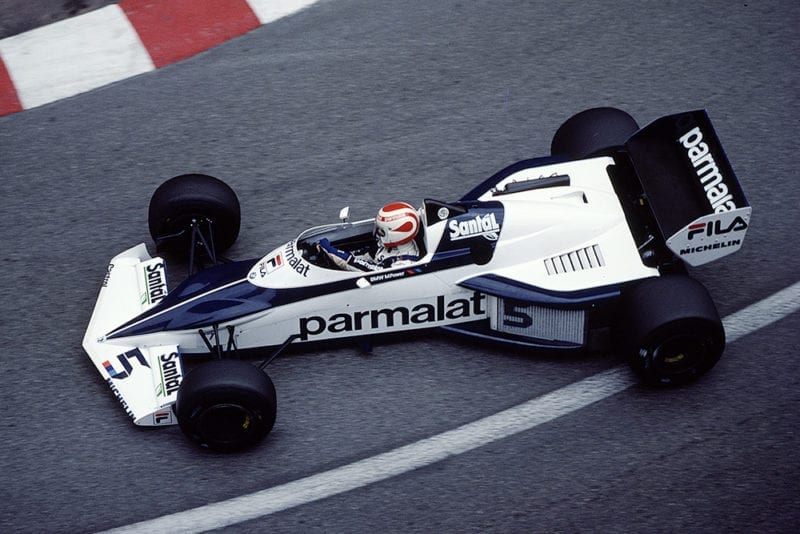
Nelson Piquet started in 6th
Motorsport Images
With the skirtless non-ground effect cars of 1983 new to the streets all the teams had to make inspired guesses as to the required settings for suspension, brakes, aerodynamics, gear ratios, tyres and all the other variables available on the Formula One car of today. Bizarre rear aerofoils seem to be this year’s fashion and the ATS team had a blatant copy of the complicated Ferrari rear aerofoil with side plates and extensions running forwards almost to the front of the engine, and Ligier and Osella had double rear aerofoils similar to the Toleman. Lotus had abandoned their four-tier rear aerofoil for the time being and the Williams team, who claim to know about these things, were lamenting their shortage of horsepower which prevented them using the aerodynamic settings they would like to have employed. It was not so much a shortage of horsepower as the fact that teams with better engines, like BMW, Ferrari and Renault, had so much more horsepower than a good Cosworth V8 that they could indulge in aerodynamic luxuries which give lots of down-force at the expense of high drag.
Qualifying
After one and a half hours of testing on Thursday morning the amount of work being done in the pits during the lunch break suggested that a lot of the guesswork was a bit wide of the mark. Some of the cars were looking really nasty out on the tight and twisty part of the circuit where it runs downhill from the Casino Square. Many of the drivers were not helping matters by bouncing wheels over the bevelled kerbs and upsetting the balance of the car, while Lauda and Tambay were particularly neat and having a smoother ride in consequence.
At 1 p.m., when the timed hour began, Piquet was at the pit lane exit ready to go and was quickly followed by Arnoux and Tambay in the Ferraris. The rest soon followed and it was not long before Laffite returned to the pits, somewhat chastened having hit a barrier and damaged both left side wheels. As this was the crucial session in which marked tyres were in use he had to wait while the tyres were removed from the damaged wheels and fitted to a new pair. Patrese had to take the spare Brabham when his own car died with an electrical fault and Piquet in the leading Brabham was not as quick as the Renaults and Ferraris. For a change Tambay was having a trouble-free day but it was Arnoux who was setting the pace, strongly challenged by Prost in the Renault. As the minutes ticked by it became another needle match between Ferrari and Renault, Prost holding fastest lap with 1 min. 25.223 sec. and while he rested Cheever went out in the second Renault but was more than a whole second off the pace. Meanwhile Arnoux was sitting in his Ferrari with a totally blank look on his face while mechanics applied cold-air blowers to the radiators and others cooled the tyres with cold water. The day itself was not very warm, at least, not for Monaco, but obviously the Ferrari team had everything wound up fairly tight and were about to give it all they had got.
Suddenly Arnoux’s engineer unplugged his inter-com, the air-starter was connected and the engine started. As Arnoux eased his way down the crowded pit lane it was obviously going to be worthwhile keeping an eye on the time-keepers’ automatic read-out which is relayed direct to the pits. After a lap in 1 min. 43 sec. to warm up Arnoux zapped round in 1 min. 25.182 sec. to snatch fastest lap from Prost, and as he returned to the pits the scrutineer’s automatic red light indicated that the next car in should be weighed! While the Ferrari was being weighed and the team were beaming happily at their little Frenchman the other little French driver in the rival team was doing a warm-up lap in 1 min. 36 sec. and then “wham” the time indicator showed 1 min. 24.840 sec. and Renault were back on pole position, and then the hour was up and it was time to take stock of the also-rans. Normally a Grand Prix circuit is allowed 26 starters on the grid, but Monaco being Monte Carlo only 20 starters are permitted, so the six slowest were going to be spectators, except that there was another chance to improve on Saturday. Or was there?
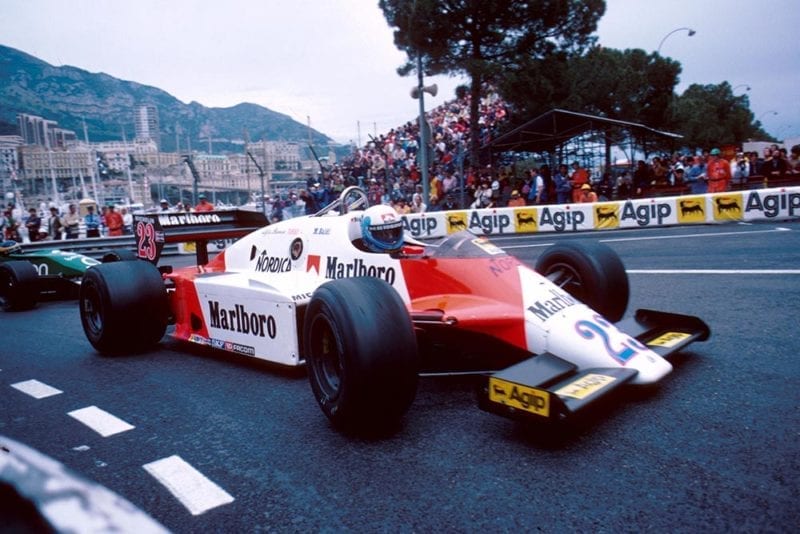
Mauro Baldi started 13th for Alfa Romeo
Motorsport Images
Apart tram Patrese being a long way down the list, due to the troubles with his Brabham-BMW, all the hard-chargers were in the “top-20” and after all the trouble in pre-qualifying early in the morning Derek Warwick was pleased to be in 10th position, with the twin-plug Hart engined Toleman. His team-mate Giacomelli was just out of the running in twenty-first position, but behind him were Lauda and Watson in the McLarens, both using DFY Cosworth power. Excuses were rife but none held water and the “party-line” from the team management was that their Michelin tyres were unsuitable for a normally aspirated engine, having been developed specially for Renault turbo-power. It was a splendid story that was blown into the harbour by the fact that the Cosworth-powered Ligier cars were both in the “top-20”, Jarier in ninth place and Boesel in 18th place, both running on Michelin tyres. There was a slight modification to the story that said that the Ligier was such an evil chassis that it heated its Michelins up to working temperatures unintentionally, whereas the McLaren International chassis was so perfect that it could not get any temperature into its Michelins!
While the McLaren situation was no real surprise, neither was the Williams situation, for Rosberg was right up among the front runners by dint of really hard press-on driving, his progress being good value for the spectators, even if it was a bit unruly. He ended up in a courageous fifth place, albeit one-and-a-half seconds slower than Prost, and that is “forever” round the streets of Monte Carlo. You simply cannot keep a good Finn down.
As the first day at Monte Carlo is inevitably a bit of a guess, everyone is relieved that there is no Formula One practice on Friday, so that they have time to re-think the whole situation. Saturday morning saw the activity starting up again under overcast skies and the pit lane was filling up with everybody and his girl friend or someone else’s wife, as is the fashion in Monaco. Some personalities were there because they love motor-racing, others because they love themselves, and one or two because it is their business, notably Signor Agnelli the number one man of Fiat, and the number two man of the Regie Renault. Although the morning was meant for testing in preparation for the final hour of qualifying, there was a lot of “testing to destruction,” among such action being the driveshafts on Piquet’s Brabham, the engine in Arnoux’s Ferrari and the front end of Salazar’s March when he understeered into a barrier. Nigel Mansell leapt smartly out of his Lotus 92/10 when the battery under the seat shorted out and passed a heavy current through the carbon in the fibre seat pan, nearly setting his backside on fire! Not everyone was in trouble and Patrese was getting into the groove with his BMW-powered Brabham, and Manfred Winkelhock shook everyone when he scratched round in the ATS to record an excellent 1 min. 25 sec., while Lauda and Watson quietly put in some laps that would put them in mid-field if they could repeat them after lunch. But it was not to be.
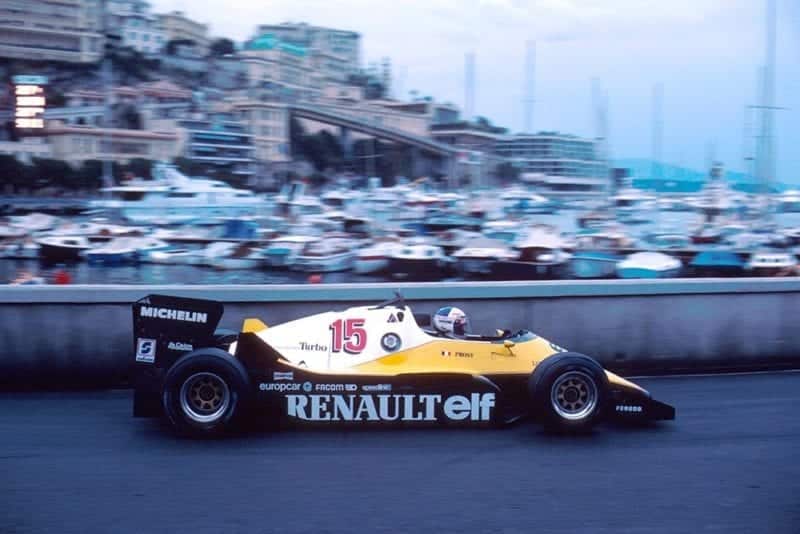
It was a principality pole for Renault’s Alain Prost
Motorsport Images
At 1 p.m. the rain was still dripping down and the town was very wet, while the wind was stirring up the sea and rocking the boats in the harbour so that many of them had their decks awash with gin and tonic. As far as qualifying for the starting grid was concerned it was all over; Thursday’s times were the ones that were going to count and while some of the non-qualifiers didn’t bother to get themselves wet, others like Lauda and Watson splashed around for no good reason. Those who were confirmed for the start, with good times, were soon skating around the circuit on wet weather tyres just in case the rain stayed for another day.
Tambay was the first to venture out, running on some new Goodyear tyres of radial construction against the American firm’s normal cross-ply construction. Michelin and Pirelli, of course, make all their tyres, wet or dry, in radial form. The other Goodyear users, like the Williams team and the Tyrrell team, were also using the new radial wet-weather tyres and Rosberg was again good value for the damp spectators. He doesn’t display the artistry of a Stewart or a Villeneuve, but he does have the courage and skill of a Peterson, and he should be paid special “appearance money” by FOCA for he keeps the paying customers happy, wet or dry. Needless to say he made the best time of the afternoon with 1 min. 52.030 sec., just beating Arnoux in his spare Ferrari, who recorded 1 min. 52.183 sec. Some idea of how slippery the circuit was can be gained from the fact that lap times were nearly 30 seconds slower than in the dry.
As if to issue a warning to Formula One to “watch it” the rain stopped when the qualifying hour was over and the scene dried quite rapidly for the supporting events, but it returned in the evening as everyone contemplated the Sunday race and the starting grid without the McLaren team and with Patrese (Brabham) and de Angelis (Lotus) right down at the back. The former had good excuse to be there with tangible reasons and troubles with his Brabham-BMW, but the latter seemed to spend most of the time moaning about everything except the colour of the Lotus-Renault and the money he was being paid!
Race
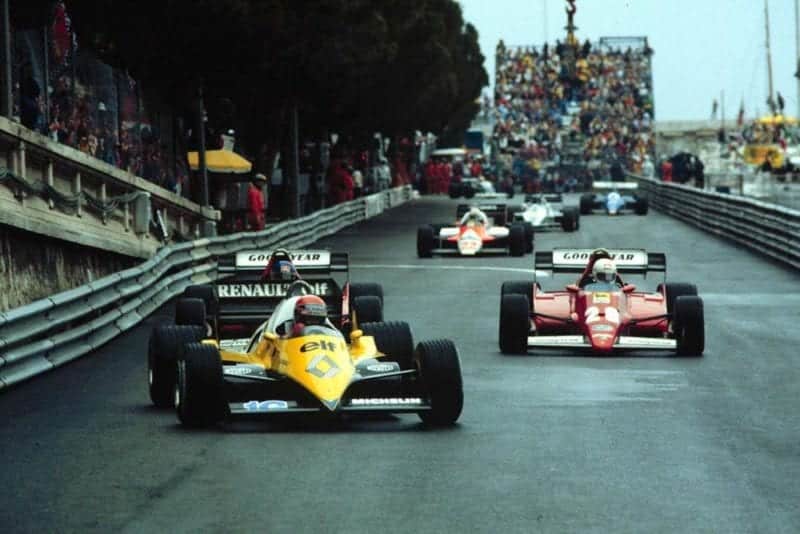
Front row man Rene Arnoux and team mate Patrick Tambay hound Eddie Cheever in the first few laps.
Motorsport Images
While everyone surfaced on Sunday morning the rain poured down and as all the grandstands around the circuit are uncovered it was a very wet and miserable crowd that assembled to watch a race that was going to bear little relationship to reality. By 11 a.m. when the old sports cars had their 10 laps race the rain had stopped and before Martin Morris had completed his start to finish win the streets were drying rapidly and even the narrow tyres of the old cars were beginning to make a “dry line” round the circuit. The Formula One “warm-up” started at 12.30 p.m. for 30 minutes, but continuous spatterings of rain kept parts of the circuit damp so that even though treadless dry weather tyres were being used by most of the twenty starters it was impossible to do much in the way of fast laps, and as the rain returned after the “warm-up” was over nobody really knew where they were going. The Alfa Romeo team knew where they were not going, for the engine in de Cesaris’ car sprang an oil leak underneath, which took a fair time to cure, and the Toleman team stopped going anywhere when Warwick came to a stop just past the pits with a damaged turbocharger, so they were soon hard at work fitting a replacement one.
The 76 lap race was due to start at 3.30 p.m. and at 3 p.m. when the pit lane was opened it was still spitting with rain and the circuit was very damp in places, no nobody knew what was going to happen. One colleague who was watching events with four local people asked their opinion and two said the rain would hold off and it would dry up and two said the rain would return! A weather specialist said the rain would return because the wind was coming from the east, while another looked at the clouds and said they were rising so the weather would clear up and it would be dry. Not surprisingly none of the teams knew what to do as their cars went off on the warm-up lap.
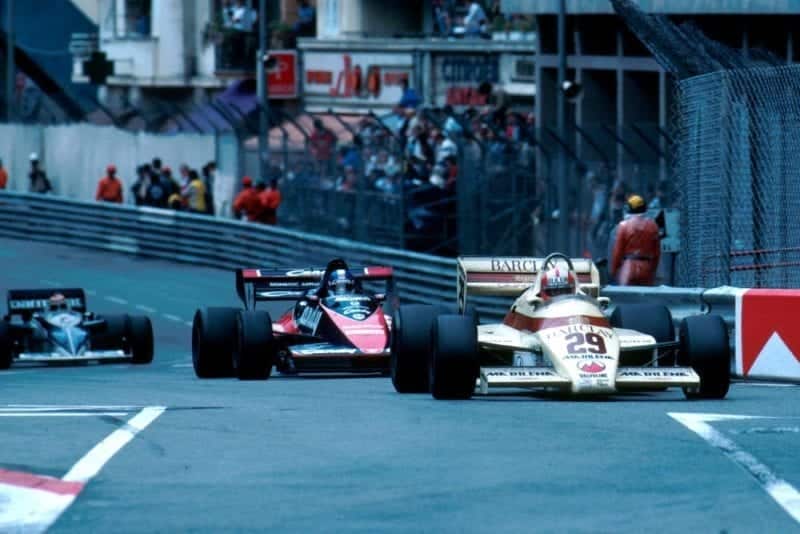
Marc Surer in his Arrows A6, he did not finish.
Motorsport Images
As the twenty cars sat on the grid awaiting the signal to start up and prepare for the parade lap final decisions had to be made as to whether to start on heavily grooved rain-tyres with all the springs, shock-absorbers and anti-roll bars adjusted to “soft” conditions for rain, as Renault decided. Whether to start on rain-tyres but with dry settings, so that if it dried up a stop could be made for dry tyres and the car would then be well set up, as Ferrari and Brabham decided to do, or whether to gamble on it drying up and start on dry tyres, hoping that the drivers could keep out of trouble in the opening laps. The Ferrari team decided that both of their drivers would start on wet-weather tyres, in spite of Tambay coming back from the warm-up lap and offering to take a chance and start on dry-weather tyres. Both Renaults were on “wets” as were both Brabhams, but Rosberg had the same feeling as Tambay and wanted to start on “dry” tyres, which suited Frank Williams and Patrick Head, as they had seen that all the front-running turbocharged cars were starting on wet tyres.
If they started both their cars on “wet” tyres the outcome was obvious, they would not keep up, but on “dry” tyres it was a fair gamble. If it dried up they were in with a chance while the others stopped to change, if it rained they would have to stop and change tyres and all hope of getting anywhere would be gone. There were three possibilities, two of which were dead-cert losers and the third was a gamble that could pay off. They gambled, as did most of the others who were not in the front-rank turbo race, including Warwick with the Toleman, the Tyrrells and Surer with his Arrows. Alan Rees hedged his bets both ways and put his second car on “wet” tyres. As the twenty cars went off on the parade lap behind Prost it was all up to the controller of the heavens. The constant spits of rain were not enough to penetrate through the trees, but enough to dampen the road where they fell, so on the starting grid those on the right like Prost, Cheever, Rosberg and de Cesaris had a dry surface and those on the left like Arnoux, Tambay, Piquet and Laffite had a damp surface on which to start. As the grid line-up bore little resemblance to what it would have been had it not rained on Saturday afternoon, the whole affair was a bit of a joke. It was a gambler’s paradise, so suitable for Monte Carlo.
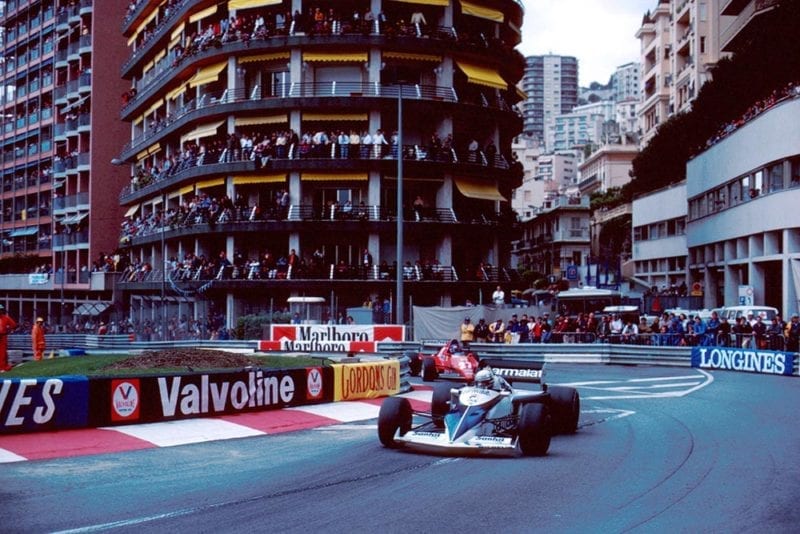
Riccardo Patrese heads Patrick Tambay
Motorsport Images
When the green starting lights shone Arnoux’s Ferrari hung with wheelspin, Prost made a good start but Rosberg simply rocketed off the line, diving down the middle into second place, managing to miss everybody this time. Up the hill it was Prost, Rosberg and Cheever with the rest hard behind and no spray coming up from the tyres, for the wind was drying the track rapidly, even though the downhill hairpins were still damp. At the back Mansell was trying to force his Lotus 92 into gaps that didn’t exist as they disappeared into the Casino Square, so it was no surprise when he tangled with Alboreto’s Tyrrell before the end of the opening lap and they were both out of the race. Before the end of the lap Rosberg had dived past the leading Renault and led the field as they started lap two, and there was already a fair sized gap between these two and the others led by Cheever.
Already the conditions were changing visibly and it was not going to rain, so all those who had started on “rain” tyres were in trouble. Rosberg made the most of the clear road ahead by “reading” the changing road surface and running on the dry patches, changing his line each lap as conditions improved. Piquet was the first in, at the end of lap four, and with a set of “dry” tyres on his Brabham was back in the race, but down in fifteenth place as a lot of time was lost on the slow entry and exit of the Monte Carlo pit lane. On the next lap Patrese was in for a tyre change, and Jarier was in with the Ligier, followed by Arnoux, but the Ferrari was in for a different reason. On lap six there had been a collision between the Ferrari and Laffite’s Williams as they descended to the sea-front before the tunnel, and the Ferrari had come off second best. While Arnoux’s car was in the pits being attended to Tambay wanted to come in for a tyre change, but he was kept out until the end of lap 10, by which time he had dropped a long way back from the leaders. Prost had been in and out at the end of lap seven, but had dropped back to eighth place, and Cheever’s stop had put him back to 12th place.
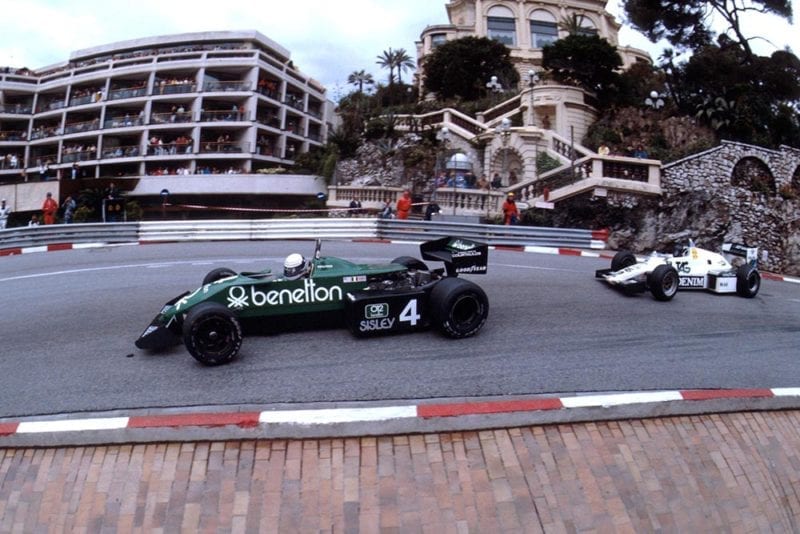
Danny Sullivan’s Tyrrell leads Jacques Laffite’s Williams.
Motorsport Images
At 10 laps the order was Rosberg well ahead of Laffite, with Surer a long way back in third place, followed by Warwick, all four having started on “dry” tyres and the gamble had paid off, for though the afternoon was not bright the rain was holding off. Behind Warwick came Prost, de Angelis, Piquet, Cheever, and Jarier, with Baldi leading the rest. Arnoux had done one more slow lap and then retired and Winkelhock had eliminated himself and Boesel’s Ligier in a collision. It was now all over, the gamblers had succeeded and the two Williams cars were uncatchable, but there was a good scrap going on behind. Surer was third in his Arrows, but it was not a secure third place for Warwick was pressing on in the Toleman-Hart, which was behaving itself for the first time in a long while, and its Pirelli tyres were performing well. The reason the Hampshire driver was pressing on was not so much that he was trying to catch Surer, but that he was being chased hard by Prost and Piquet, though they both were a bit handicapped, the Renault by reason of being too softly set up for the dry conditions and the Brabham by having its BMW boost-pressure held down in the interests of fuel economy.
With refuelling forbidden and the BT52 tank being below the maximum permitted capacity, Piquet was having to run on restricted boost and power to make the fuel last the distance. Nonetheless both he and Prost were driving hard and Warwick was doing a good job staying in front of them. Rosberg was driving brilliantly and had settled into a very consistent rhythm once the track had dried out all round, and Laffite was holding station some thirty seconds behind. After being passed by Cheever’s Renault, de Angelis stopped at the pits for more Pirelli tyres, pretending they would make an improvement to his poor progress, which they didn’t do, and meanwhile Warwick’s Pirellis were working admirably. Patrese in the second Brabham was still working away to overcome his initial starting-grid position handicap and Tambay was making fastest race laps in his endeavours to make up for the time lost while the Ferrari pit kept him out on his “wet” tyres on the dry track.
Everyone’s handicap, self imposed or acquired by chance, was too much to affect the overall result of the race, and provided Rosberg didn’t throw it away victory was there for the Williams team to take as the result of a good gamble; and second place as well. Cheever stopped out on the circuit when his Renault engine broke and Jarier’s Ligier sat down like a broody hen when the drive-belt to the hydraulic pump for the suspension broke, and without oil pressure the Citroën suspension units collapsed.
At just over half distance, on lap 43 to be exact, Rosberg had an anxious moment when his Cosworth engine missed a beat three or four times and then cut out momentarily as he dived into the swimming pool corners on the harbour front. He just had time to think “Oh ****!” when it cut in again and ran perfectly for the rest of the race. Laffite was not so lucky, for he missed a gearchange as he ended lap 53 and as he started on his next lap he knew it was not his fault, for something had broken internally and though he got back to the pits his race was run. Meanwhile the battle for third place had become very heated for Warwick and Piquet had caught Surer, and the Arrows, Toleman and Brabham were nose to tail. Prost was having trouble finding fourth gear and had dropped back, while Rosberg’s slight hesitation in his rhythmic progress had allowed Patrese to get by the Williams and on to the same lap, though Tambay was still a lap behind, but going very fast and smoothly. A piece of the complicated rear aerofoil on the Ferrari had broken off, which changed the “trim” of the car slightly, but Tambay was easily able to allow for it.
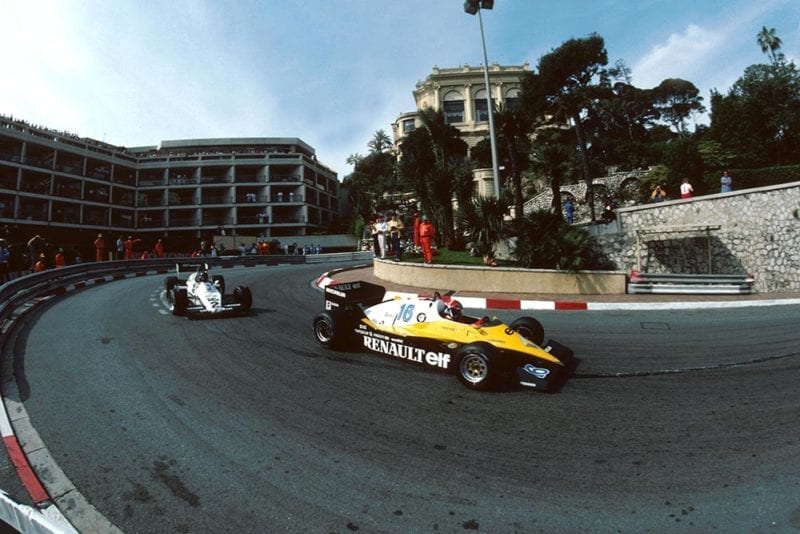
Both Renault’s Cheever and Williams’ Laffite retired with mechanical issues
Motorsport Images
As Surer was completing lap 49 Warwick was looking for a way by and Piquet was watching the two of them. Both drivers were driving hard with more at stake than ever before, and the inevitable happened. Surer inadvertently squeezed Warwick over to the left as they passed the pits and then when braking for the St. Devote “chicane” from 130 m.p.h. the Toleman hit the Arrows and punted it into the guard rails. Surer was out on the spot while the Toleman bounced off into the rails and wrecked its left rear suspension. While a smiling Nelson Piquet went by into third place, soon to become second place when Laffite retired, alas poor Warwick limped round to the pits to retire from his moment of glory. As he did so de Angelis was back in the pits with the Lotus-Renault for more Pirelli tyres and as he set off again a drive-shaft broke which saved everyone a lot of embarrassment. Meanwhile the Pirelli engineers were looking at the tyres on the Toleman, which had been driven hard, and were delighted with their condition. Patrese had recorded fastest lap of the race, improving on Tanabay’s times, but then had to stop for a tyre change and this let the Ferrari by into fourth place for the Frenchman’s speed had carried him by Rosberg, to be on the same lap as the leader. After his stop Patrese’s BMW engine coughed and died, then picked up again, and then died altogether with a malfunctioning in the fuel system.
With the end in sight Piquet wound things up for a couple of laps and snatched the fastest lap from his team-mate, but could not make any impression on the flying Rosberg, so settled back in second place a comfortable few seconds ahead of Prost. Only four cars completed the full 76 laps, Rosberg winning in 1 hr. 56 min. 38.121 sec. having driven hard the whole way, so much so that he had blistered his hands and was very relieved to be able to stop, but it was a fine example of his tenacity and enthusiasm and a well deserved “gambler’s win”. He was followed home by Piquet, Prost and Tambay on the same lap so it was Williams-Cosworth V8, Brabham-BMW 4 cyl., Renault V6 and Ferrari V6, an interesting result for the Golden Book, but one that bore little resemblance to reality.
The remaining three runners were Sullivan (Tyrrell), Baldi (Alfa Romeo) both of whom had had non-stop runs, and Serra (Arrows) who had stopped to change on to “dry” tyres. All three were two laps behind the winner, but at least they had kept off the guard-rails and clear of trouble, unlike many others. The Monaco GP is invariably unpredictable, but this year it excelled and while the Williams team were grinning at each other, Ferrari, Renault and Brabham were looking a bit miserable, realizing they had “goofed” in more ways than one. Arrows and Toleman were thinking “well at least we were right in there for a bit” while the McLaren International team were not looking at anyone. They had gone off to cry in their beer. It wasn’t a memorable race because of the motor racing but it will become memorable because of the weather and in a few years time we shall say “. . . do you remember when Rosberg and the Williams team. . . .” — D.S.J.
